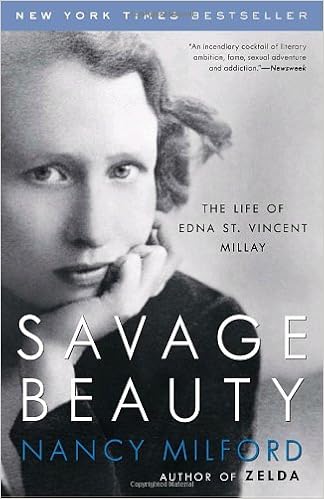On this
date in 1950, Edna St. Vincent Millay died.
In her honour, I thought I’d post my notes on a biography of her which I
read a number of years ago: Savage Beauty: The Life of Edna St. Vincent Millay by
Nancy Milford. I’m not a biography
reader but I’ve always loved Edna St. Vincent Millay’s sonnets and even own a
first edition of her Collected Sonnets.
In some
ways I wish I hadn’t read the book: the
poet was not always a nice person. I
knew a little about her beforehand: in
the heart of the Depression, her collection of sonnets sold thousands of
copies; she was the first woman to win the Pulitzer Prize for Poetry; she was
the first American figure to rival the frenzy surrounding Lord Byron whose life
and work shocked the public.
The book
discusses the influences of Edna’s mother, Cora Millay, who was very ambitious
for her daughters: “She made [them] –
oh, not ordinary” (9). One observer mentioned
that she had “never come across a more devoted mother and daughter” (176), and
Milford concludes that “the love of [Millay’s] life remained her mother”
(205). Cora saw her daughter’s triumphs
as “part of their triumph” (206). The relationship, however, was not without
its problems: one man noted that Edna’s mother
was “a bit in awe of her. That she had
created such a creature” (234), and the mother wrote that her own indiscretions
might be the cause of Edna’s sexual liberality (237). At times Edna seemed to flee from her mother
but then would feel guilty and would assuage her guilt by sending money (207).
Writing poetry
was the most important thing in Millay’s life.
By 16, she had a sense of vocation (41).
“[Edna] drew people to her . . . [but] her work came first . . . it was
her first love, and perhaps her only one” (130). Milford observes, “people were in some sense
unimportant to her – except as subjects for poems . . . What she was interested
in was her own emotions about them” (199).
In many
ways, Edna was a very selfish and vain person, “the oddest mixture of genius
and childish vanity, open mindedness and blind self-worship” who had “build up
so enormous an image of herself as the Enchanted Little Faery Princess that she
must defend it with her life” (462). “Edna
did exactly what she pleased, when she pleased, and where she pleased” (419),
perhaps unsurprising for a woman who in 1938 was voted one of the ten most
famous women in America (418). She knew “how
to rule a situation or a group” (291), but social approval was very important
to her.
Edna’s life
was anything but orthodox since she had affairs with both men and women. Her promiscuity was well-known in her
circle. Milford suggests that Edna was “irresistibly
drawn to relationships that were doomed to fail. Maybe she couldn’t bear the weight of a
permanent attachment, in which she had no reason to believe” (205) since a
central theme of one of her plays is that the enduring love between women is
the only bond that lasts. Edna flaunted
her sexuality to her mother (234) who aborted her own grandchild when Edna
became pregnant (239).
The one “permanent”
relationship was with her husband, Eugen Jan Boissevain, with whom she had “an
open, free marriage” (351). His devotion
was complete; he even offered to “go and live by himself” (355) and refused to
be “a piece of irritating, dragging piece of family” (357) if he could help
Edna’s extra-marital affair with another man.
Eugen was also sexually involved with other women, and these affairs
were discussed openly by husband and wife” (356). Her lovers knew about Eugen; she wrote one
lover that “I am devoted to my husband.
I love him more deeply than I could ever express, my feeling for him is
in no way changed or diminished since I met you” (305 – 306). Milford even suggests that Eugen “took
morphine so that he would know what it was like for her to be addicted – so that
he would know what she went through trying to stop it” (481).
The
biography was obviously very thoroughly researched. Milford examined numerous documents which are
quoted and cited. She also had the
assistance of Norma, Edna’s surviving sister.
The title is very appropriate: it
describes the audacious poet and the writing of the biographer who spared no
details.

No comments:
Post a Comment